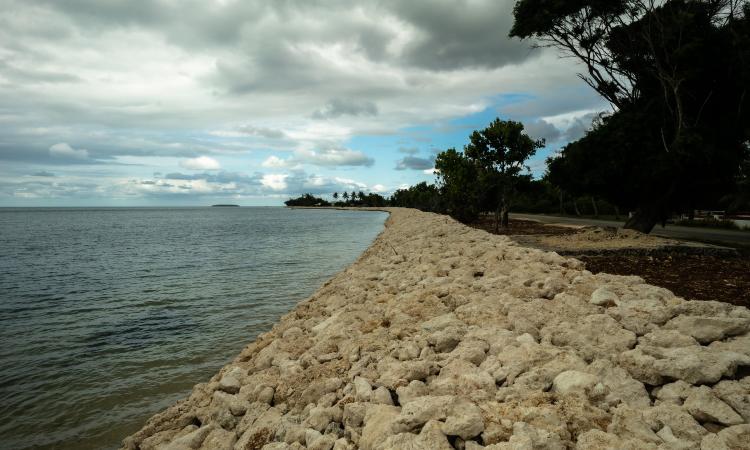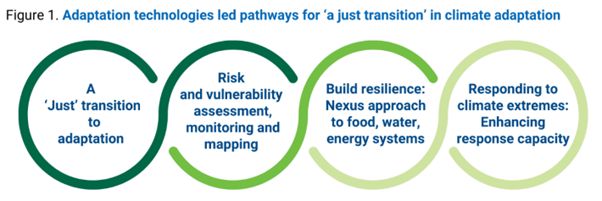
Breaking heat records in the summer of 2024 is a stark reminder of the harsh reality of a warming planet. According to figures from the Indian Health Ministry, the heatwave in India alone has resulted in over 40,000 cases of heatstroke and over 100 fatalities in recent months. The impoverished and vulnerable have been significantly impacted by this catastrophic weather event, which has increased the social and financial cost of disasters.
‘A just transition’ in climate adaptation
Global warming poses risks, but adaptation is always local, and resilience is unique to an environment, community, and its inhabitants. The best course of action in the vulnerable setting is to emphasise "a just transition" and adopt an inclusive approach to climate change adaptation. This strategic priority is emphasised in India's National Adaptation Communication to the United Nations Framework Convention on Climate Change (2023). This commitment was further reflected by the significant increase in adaptation finance, with total adaptation expenditure reaching 5.6 per cent of the GDP in 2021-2022 growing from a share of 3.7 per cent in 2015-16.
Bihar case: Intersection of multi-dimensional poverty and climate risk
Extreme weather events bring vulnerabilities that are already on the verge of tipping points closer to their limit when they combine with multifaceted poverty. India's Bihar state serves as an example of this difficulty. Bihar has the highest percentage of multidimensionally impoverished people, according to NITI Aayog's 2021 National Multidimensional Poverty Index (MPI) baseline report.Additionally, the state is ranked lowest in the SDG Index Report by NITI Aayog, with more than 60% of the districts being categorised as highly vulnerable.
This disproportionate impact of disasters on the poor is evident in eastern parts of India, where the lowest MPI values of Bihar coincide with districts which are perennially prone to floods.
Bihar’s draft report on climate-resilient and low carbon development pathway (2024) emphasises the need for resilient communities. Building resilient communities in vulnerable context requires adopting adaptation technologies backed by grassroots innovations and risk informed policy interventions.
The Indian Institute of Technology Patna, which is situated in Bihar, has the potential to significantly contribute to bridging the state's technological adaptation gap, guiding a fair transition in adaptation, and encouraging teamwork to create equitable climate resilience. The secret to its effective use in the multifaceted context of poverty is a reasonable transition strategy based on adaption technology applications.
Multi-pronged adaptation strategies
The implementation of adaptation techniques necessitates the convergence of several strategies, from locally driven interventions to strong governmental frameworks and financial incentives. Every policy response must start with an understanding of the risk and vulnerability situation. Targeting disadvantaged and at-risk groups to implement "a just transition" adaptation policy requires careful planning and monitoring.
To take advantage of inter- and cross-sectoral linkages and synergies, the strategy must shift from a sector to nexus approach. In the event of a crisis, this is crucial to prevent compounding and cascading effects across the sectors. Technologies for adaptation provide for "just transition" paths, risk assessment, resilience development, and climate extreme response (Figure 1).

Key enablers: An adaptation technology cluster
Three groupings make up adaptation technologies: data science and risk analytics, engineering-based, and science-intensive (Figure 2). Customisation and scaling up in a particular environment of vulnerabilities provide challenges.For instance, ESCAP’s Risk and Resilience Portal combines the three groups and provides a special tool for visualising baseline, 1.5, and 2 degree future climate scenarios. Understanding the shifting risks of heatwaves, droughts, floods, and tropical cyclones is essential for anticipatory planning and early warning systems for the dynamic hazard landscape.

Opportunity for action: Operationalise adaptation technology cluster
India is implementing adaptation technology on a large scale to facilitate "a just transition" in situations where people are vulnerable. Priorities for adaptation that are unique to a given location are addressed by the Mahatma Gandhi National Employment Guarantee Act (MGNREGA), which has an annual budget of $13 billion (2020). Assets pertaining to water harvesting, drought relief, flood control, and sanitation are developed nationwide under MNREGA.
Satellite derived Location based services are being utilised for planning and monitoring of nearly 7-8 million assets annually using mobile-based geo-tagging. The online geo-spatial maps with more than 30 million assets geotagged for all MGNREGA works across the country has been a game changer.
Scaling adaptation technology cluster has helped in policy execution for social empowerment of poor and vulnerable population with leak-proof public delivery systems. Utilising the JAM Trinity (Jan Dhan, Aadhaar, Mobile), over $406.9 billion has been transferred to 11.67 billion beneficiaries. Real-time monitoring via geo-tagging enhances transparency and financial inclusion of poor and vulnerable through targeted policy schemes.
Further, start-up ecosystems are helping to scale adaptation technologies. For example, there are more than 2800 AgriTech start-ups in India driving innovation and transforming agriculture to adapt to climate risk situation. Having embraced Internet of Things (IoT) -enabled agricultural practices to now AI-enabled machines and tech, this burgeoning start-up ecosystem is quite promising.
It is critical to make use of the current technological breakthroughs to help the most disadvantaged people in India. In order to advance research, knowledge creation, and capacity building in India's most vulnerable context—with an emphasis on inclusiveness and climate justice—it is imperative to establish a dedicated institute for climate change adaptation technologies.
Authors
- Sanjay Srivastava, Chief of Disaster Risk Reduction Section, ESCAP
- Professor T N Singh, Director, Indian Institute of Technology (IIT), Patna/India
- Praveen Kumar, CEO (FIST-TBI), IIT Patna/India
- Naina Tanwar, Consultant, Disaster Risk Reduction Section, ESCAP
/articles/scaling-climate-adaptation-technology-just-transition